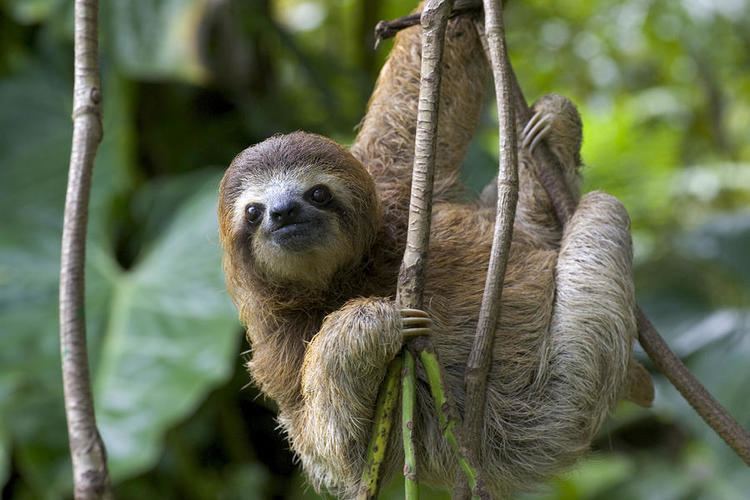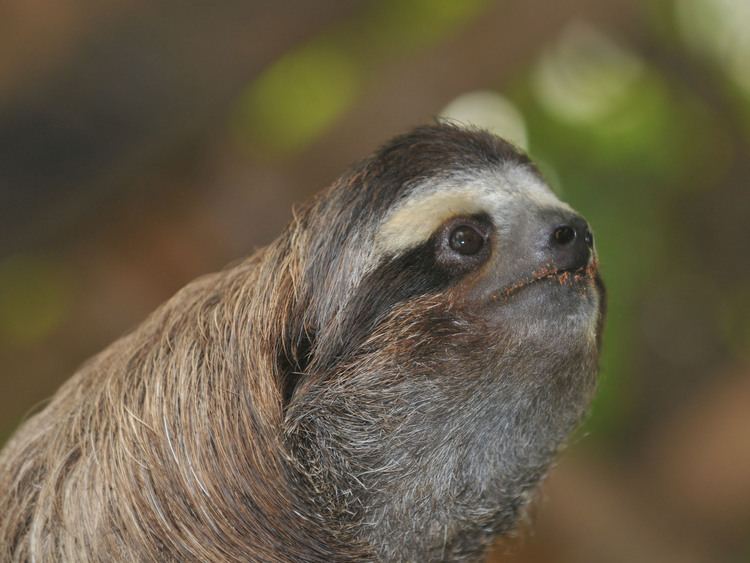Genus Bradypus Mass 2.2 – 6.3 kg (Adult) Rank Species Higher classification Three-toed sloth | Phylum Chordata Family Bradypodidae Scientific name Bradypus variegatus Length 42 – 80 cm (Adult) Daily sleep 15 – 18 hours (Adult) | |
 | ||
Similar Three‑toed sloth, Sloth, Two‑toed sloth, Hoffmann's two‑toed sloth, Pale‑throated sloth | ||
Brown throated sloth bradypus variegatus
The brown-throated sloth (Bradypus variegatus) is a species of three-toed sloth found in the neotropical ecozone.
Contents
- Brown throated sloth bradypus variegatus
- Brown throated sloth
- Description
- Distribution and habitat
- Behaviour and diet
- Reproduction
- Subspecies
- References
It is the most common of the four species of three-toed sloth, and is found in the forests of South and Central America.

Brown throated sloth
Description

The brown-throated sloth is of similar size and build to most other species of three-toed sloths, with both males and females being 42 to 80 cm (17 to 31 in) in total body length. The tail is relatively short, only 2.5 to 9 cm (1.0 to 3.5 in) long. Adults weigh from 2.25 to 6.3 kg (5.0 to 13.9 lb), with no significant size difference between males and females. Each foot has three fingers, ending in long, curved claws, which are 7 to 8 cm (2.8 to 3.1 in) long on the fore feet, and 5 to 5.5 cm (2.0 to 2.2 in) on the hind feet.

The head is rounded, with a blunt nose and inconspicuous ears. As with other sloths, the brown-throated sloth has no incisor or canine teeth, and the cheek teeth are simple and peg-like. They have no gall bladder, cecum, or appendix.

The brown-throated sloth has grayish-brown to beige-color fur over the body, with darker brown fur on the throat, the sides of the face, and the forehead. The face is generally paler in color, with a stripe of very dark fur running beneath the eyes.

The guard hairs are very coarse and stiff, and overlie a much softer layer of dense under-fur. The hairs are unusual in lacking a central medulla, and have numerous microscopic cracks across their surfaces. These cracks are host to a number of commensal species of algae, including Rufusia pillicola, Dictyococcus bradypodis, and Chlorococcum choloepodis. The algae are generally absent in the hair of young sloths, and may also be absent in particularly old individuals, where the outer cuticle of the hair has been lost. Sloth hair also harbours a rich fungal flora.
Over parts of its range, the brown-throated sloth overlaps the range of Hoffmann's two-toed sloth. Where this overlap occurs, the three-toed sloth tends to be smaller and more numerous than its relative, being more active in moving through the forest and maintaining more diurnal activity.
Distribution and habitat
The brown-throated sloth is the most widespread and common of the three-toed sloths. It is found from Honduras in the north, through Nicaragua, Costa Rica and Panama into Venezuela, Colombia, Ecuador, Bolivia, and eastern Peru. It is probably not found north of the Amazon Rainforest or east of the Rio Negro, although its similarity to the pale-throated sloth found in these regions has led to some confusion in the past.
It is found in many different kinds of environments, including evergreen and dry forests and in highly perturbed natural areas. It is generally found from sea level to 1,200 m (3,900 ft), although some individuals have been reported from much higher elevations.
Behaviour and diet
Brown-throated sloths sleep 15 to 18 hours every day and are active for only a few brief periods, which may be during either the day or night. Although they can walk along the ground, and even swim, they spend most of their lives in the high branches of trees, descending once every eight days or so to defecate in the soil. Adult animals are solitary, except when raising young, and males have been observed to fight one another using their fore claws.
Brown-throated sloths inhabit the high canopy of the forest, where they eat young leaves from a wide range of different trees. They do not travel far, with home ranges of only around 0.5 to 9 ha (1.2 to 22.2 acres), depending on the local environment. Within a typical, 5-hectare (12-acre) range, a brown-throated sloth will visit around 40 trees, and may specialise on one particular species, even spending up to 20% of its time in a single specific tree. Thus, although the species are generalists, individual sloths may feed on a relatively narrow range of leaf types.
In addition to the algae in their fur, brown-throated sloths also live commensally with a species of moth, Cryptoses choloepi, which lives in their fur, and lays its eggs in the dung. Jaguars and harpy eagles are among the few natural predators of the brown-throated sloth. The yellow-headed caracara has been observed to forage for small invertebrates in the fur of the sloths, apparently without the sloth being disturbed by the attention.
The female of the species is known to emit a loud, shrill scream during the mating season to attract males. Its cry sounds like "ay ay", much like that of a woman screaming. The male can be identified by a black stripe surrounded by orange fur on its back between the shoulders.
Reproduction
Studies of the brown-throated sloth indicate that mating is most common between January and March in at least the northern parts of its range, but this may vary elsewhere. Gestation lasts at least seven months, and the single young is born fully furred and clawed. Young sloths cling to the mother's underside for five months or more, even though they are fully weaned after just four to five weeks.
The female's mammary glands do not store significant quantities of milk as most other mammals do, since the lactating infant sloth remains attached to the nipple at all times, and consumes the milk as soon as it is generated. The young begin to take solid food as early as four days after birth, initially licking particles of food from their mother's mouths. This process apparently allows them to quickly identify edible leaves, and young sloths typically have the same preferences for leaf types as their mothers.
In the wild, the lifespan of adult brown-throated three-toed sloths is typically between 30 and 40 years.
Subspecies
The seven recognized subspecies of the brown-throated sloth, although these are not all readily distinguishable, are:
The closest living relative of the species is the pale-throated sloth, which has a very similar appearance, except for the color of the fur around the throat. The two species are estimated to have diverged just 400,000 years ago, whereas their ancestors diverged from the maned sloth over seven million years ago.
